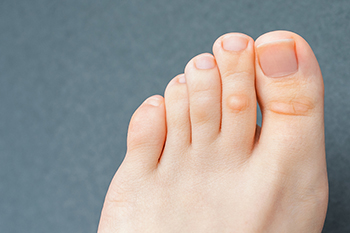
A corn is one of the ways the body protects damaged skin against excessive friction. It is a small, hardened area of skin that can form on various areas of the foot. These can include the pinky toe, the soles of the feet, or the top of the toes. A corn that develops on the side of the pinky toe can be painful, and wider shoes may need to be purchased that may help to bring partial relief. Hard corns are found in the above areas and often occurs as a result of wearing shoes that do not fit correctly. Soft corns can be found between the toes, and are named for the consistent moisture that is found there. If the corn is small, a protective pad can be worn over it which may reduce the pressure from the shoe. Patients who have larger corns are often seen by a podiatrist who can use effective techniques for removal. Please confer with this type of doctor who can guide you toward effective prevention methods.
Corns can make walking very painful and should be treated immediately. If you have questions regarding your feet and ankles, contact Frederick Matthews, DPM of Innovative Foot and Ankle Care. Our doctor will treat your foot and ankle needs.
Corns: What Are They? And How Do You Get Rid of Them?
Corns are thickened areas on the skin that can become painful. They are caused by excessive pressure and friction on the skin. Corns press into the deeper layers of the skin and are usually round in shape.
Ways to Prevent Corns
There are many ways to get rid of painful corns such as:
- Wearing properly fitting shoes that have been measured by a professional
- Wearing shoes that are not sharply pointed or have high heels
- Wearing only shoes that offer support
Treating Corns
Although most corns slowly disappear when the friction or pressure stops, this isn’t always the case. Consult with your podiatrist to determine the best treatment option for your case of corns.
If you have any questions please feel free to contact our office located in Plano, TX . We offer the newest diagnostic and treatment technologies for all your foot and ankle needs.
